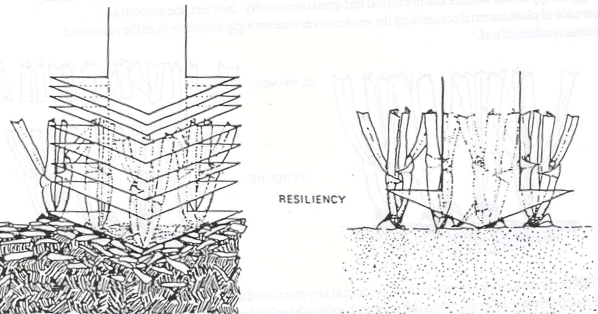Up until now we’ve looked at issues that are largely functions of the turf grass plants themselves. Today we are looking at turf resiliency, which is a measure of the combined effect of grass plants and the medium they are growing in or what we call the turf.
Turf resiliency is a measure of a turf’s capacity to retain its surface character during and after shock or stress. In this case the shocks and stresses we are mainly concerned with are those from bowling, including the downward pressure from bowls, feet and maintenance traffic.
As we have seen already, the grass plants themselves contribute to resiliency in terms of their rigidity and or elasticity. Laterally growing grass shoots and leaves can also aid resiliency of the turf as they absorb some of the pressure that would otherwise impact on the turf as a whole.
Although the grass plants are important in achieving the right level of resiliency, the soil medium in which they are growing is largely responsible for the overall resiliency of the bowling green. Thatch in particular plays a big role in achieving the desired effect. The ideal is achieved with a dense, tight sward of fine bent/fescue grass growing on a sandy loam with a maximum of around 5mm of thatch thickness. Good aeration and drainage with freedom from major areas of compaction all go towards making the green resilient enough to receive the delivery of bowls without compressing too much which would sap the energy of the shot.
When thatch is excessively thick it will sap the energy from bowls, create uneven runs and significantly reduce green speed and trueness.
On heavily compacted turf the effect will be a turf that is too hard, making bowls hard to control and in may cases resulting in shallow rooting grasses that contribute to skinning at the heads.
Soil type and texture, thatch and compaction control and good turf grass health lead to a green that offers the perfect balance of resilience and speed.
Measuring
Now that we are in the thick of the more functional attributes of green performance, we are moving in to territory that allows us to make objective measurements. There have been a lot of advances in turf performance measurement of late and I’ll be covering some of the methods and equipment used in a few days from now.
This Series
Meantime you can review the previous articles in this series as follows:
Part 1. The Performance Evaluation of the Bowling Green
Part 5. Turf Grass Growth Habit
Part 6. Turf Grass Smoothness and Colour

